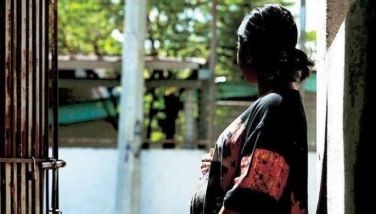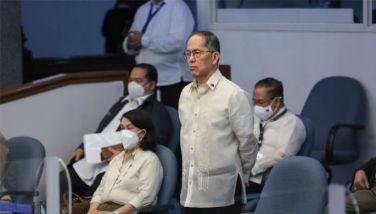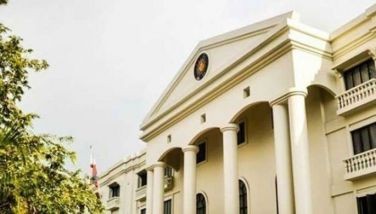US: Evidence of MILF-JI ties strong
March 10, 2005 | 12:00am
WASHINGTON — Despite repeated denials by the secessionist Moro Islamic Liberation Front (MILF), evidence shows it has strong links with Jemaah Islamiyah and provides the Indonesian terror group training facilities in its area of control in Mindanao, an updated US report on terrorism in Southeast Asia said.
"Evidence, including the testimonies of captured Jemaah Islamiyah leaders, has pointed to strong links between the MILF and JI, including the continued training of JI terrorists in MILF camps," said the Congressional Research Service report.
The report, first issued in November 2003 and updated last month, said the training appears to be important to Jemaah Islamiyah’s ability to replenish its ranks as more and more of its members are arrested. The updated version of the report, disclosed by the State Department’s Foreign Press Center on Tuesday, said there has been considerable debate over the relationship between Jemaah Islamiyah and the al-Qaeda terrorist network.
Although many analysts at first assumed Jemaah Islamiyah is al-Qaeda’s Southeast Asian affiliate, recent reporting — including leaks from interrogations of captured Jemaah Islamiyah and al-Qaeda operatives — has shown that the two groups are discrete organizations with differing, though often overlapping, agenda.
Whereas al-Qaeda’s focus is global and it definitively targets Westerners and Western institutions, Jemaah Islamiyah is focused on radicalizing Muslim Southeast Asia, the report said. "That said, the two networks have developed a highly symbiotic relationship. There is some overlap in membership. They have shared training camps in Pakistan, Afghanistan and Mindanao."
It said joint military exercises between the Philippines and the United States in the southern Philippines in 2002, during which the United States deployed nearly 1,200 troops, weakened the Abu Sayyaf and reduced its estimated strength to between 300 and 400.
But new evidence has surfaced that the Abu Sayyaf — considered a terrorist group by the Philippines, the United States and the European Union — is active in Manila as well, the report said. The Abu Sayyaf is believed to be responsible for the Valentine’s Day bombings that killed 13 people and wounded over 100 in the cities of Davao, General Santos and Makati.
Ties between the MILF and the al-Qaeda-linked Jemaah Islamiyah were first reported in 2002 by American broadcaster Cable News Network (CNN), citing intelligence documents it had obtained.
It reported that Saudi terror mastermind Osama bin Laden had asked the MILF leader Hashim Salamat in the early 1990s to set up JI training camps in the Philippines. By 1998, the MILF had at least one training camp for al-Qaeda fighters inside the MILF’s sprawling base Camp Abubakar in Maguindanao province in Mindanao, CNN said.
Further, al-Qaeda’s ties with the MILF reportedly date back to the Soviet war in Afghanistan when the MILF reportedly sent 1,000 guerrillas to help the Afghans fight the Soviets.
In 1995, Omar al-Faruq, a Kuwaiti, entered the Philippines using a false passport and visited the MILF and helped set up the training facility in Central Mindanao, CNN reported. About 1,000 Indonesians reportedly were trained at the camp, which was designated as "Camp Hudeibiah." Later a second training camp, called "Camp Palestine," was set up also at Camp Abubakar, in Maguindanao province. Abubakar fell in a massive military offensive in 2000 but no al-Qaeda training camps were reported.
Al-Faruq, who is now in US custody, confessed that he was al-Qaeda’s senior representative in Southeast Asia.
CNN reported that Al-Faruq even stayed with the MILF for three years before moving to Indonesia, where he began recruiting terrorists for al-Qaeda. He was arrested in June 2002 by Indonesian authorities, from where he allegedly had been working to unite militant groups from several countries in Southeast Asia for al-Qaeda’s cause.
Al-Qaeda transferred its operations to Southeast Asia after the fall of its bases in Afghanistan due to the 2001 US invasion, CNN reported, citing intelligence sources. The region reportedly now has the "highest concentration" of al-Qaeda operatives outside Afghanistan and Pakistan.
The 12,500-member MILF has been waging a decades-old guerrilla campaign to set up an independent Islamic state in Mindanao.
Despite denials from the MILF, persistent reports have linked the rebels to Jemaah Islamiyah. The government is currently resuming peace negotiations with rebels.
In 2003, the Arroyo administration contemplated designating the MILF as a terrorist organization following two bomb attacks in Davao City and an attack on the town of Siocon in Zamboanga del Norte early in the year.
It also threatened to request the US government to include the MILF in its list of terrorist organizations, a move that would put a squeeze on its sources of funds. The government backed down after a categorical renunciation of terrorism from Salamat, who died in July 2003 from a heart attack.
The MILF is the only rebel group in the country not yet considered a terrorist group by the government.
In 2002, the United States and European Union added the Communist Party of the Philippines and its armed wing, the 9,000-strong New People’s Army, to their list of terrorist organizations. The CPP protested the terrorist tag, saying it was a legitimate revolutionary movement. It has been waging its guerrilla war since 1969, making it one of the world’s longest communist insurgencies.
Moves to pass an anti-terrorism law were set in motion again following the Valentine’s Day bombings and the government got expert advice from a team of United Nations experts in drafting the legislation.
The UN team offered to help the Philippine government in defining "terrorism" within an international legal framework, the Department of Foreign Affairs said.
The Philippines does not have an anti-terrorism law and moves to enact such legislation have been stalled by the definition of terrorism itself.
In the absence of an anti-terrorism law, Malacañang issued a guideline in 2002 defining "terrorism" as the "premeditated use or threatened use or actual use of violence or means of destruction perpetrated against innocent civilians or non-combatants or against civilian or government properties, usually intended to influence an audience."
Its purpose is "to create a state of fear that will aid in extorting, coercing, intimidating or causing individuals and groups to alter their behavior. Its methods, among others, are hostage-taking, piracy or sabotage, assassination, threat, hoaxes, and indiscriminate bombings or shootings," the guideline stated.
"Evidence, including the testimonies of captured Jemaah Islamiyah leaders, has pointed to strong links between the MILF and JI, including the continued training of JI terrorists in MILF camps," said the Congressional Research Service report.
The report, first issued in November 2003 and updated last month, said the training appears to be important to Jemaah Islamiyah’s ability to replenish its ranks as more and more of its members are arrested. The updated version of the report, disclosed by the State Department’s Foreign Press Center on Tuesday, said there has been considerable debate over the relationship between Jemaah Islamiyah and the al-Qaeda terrorist network.
Although many analysts at first assumed Jemaah Islamiyah is al-Qaeda’s Southeast Asian affiliate, recent reporting — including leaks from interrogations of captured Jemaah Islamiyah and al-Qaeda operatives — has shown that the two groups are discrete organizations with differing, though often overlapping, agenda.
Whereas al-Qaeda’s focus is global and it definitively targets Westerners and Western institutions, Jemaah Islamiyah is focused on radicalizing Muslim Southeast Asia, the report said. "That said, the two networks have developed a highly symbiotic relationship. There is some overlap in membership. They have shared training camps in Pakistan, Afghanistan and Mindanao."
It said joint military exercises between the Philippines and the United States in the southern Philippines in 2002, during which the United States deployed nearly 1,200 troops, weakened the Abu Sayyaf and reduced its estimated strength to between 300 and 400.
But new evidence has surfaced that the Abu Sayyaf — considered a terrorist group by the Philippines, the United States and the European Union — is active in Manila as well, the report said. The Abu Sayyaf is believed to be responsible for the Valentine’s Day bombings that killed 13 people and wounded over 100 in the cities of Davao, General Santos and Makati.
Ties between the MILF and the al-Qaeda-linked Jemaah Islamiyah were first reported in 2002 by American broadcaster Cable News Network (CNN), citing intelligence documents it had obtained.
It reported that Saudi terror mastermind Osama bin Laden had asked the MILF leader Hashim Salamat in the early 1990s to set up JI training camps in the Philippines. By 1998, the MILF had at least one training camp for al-Qaeda fighters inside the MILF’s sprawling base Camp Abubakar in Maguindanao province in Mindanao, CNN said.
Further, al-Qaeda’s ties with the MILF reportedly date back to the Soviet war in Afghanistan when the MILF reportedly sent 1,000 guerrillas to help the Afghans fight the Soviets.
In 1995, Omar al-Faruq, a Kuwaiti, entered the Philippines using a false passport and visited the MILF and helped set up the training facility in Central Mindanao, CNN reported. About 1,000 Indonesians reportedly were trained at the camp, which was designated as "Camp Hudeibiah." Later a second training camp, called "Camp Palestine," was set up also at Camp Abubakar, in Maguindanao province. Abubakar fell in a massive military offensive in 2000 but no al-Qaeda training camps were reported.
Al-Faruq, who is now in US custody, confessed that he was al-Qaeda’s senior representative in Southeast Asia.
CNN reported that Al-Faruq even stayed with the MILF for three years before moving to Indonesia, where he began recruiting terrorists for al-Qaeda. He was arrested in June 2002 by Indonesian authorities, from where he allegedly had been working to unite militant groups from several countries in Southeast Asia for al-Qaeda’s cause.
Al-Qaeda transferred its operations to Southeast Asia after the fall of its bases in Afghanistan due to the 2001 US invasion, CNN reported, citing intelligence sources. The region reportedly now has the "highest concentration" of al-Qaeda operatives outside Afghanistan and Pakistan.
The 12,500-member MILF has been waging a decades-old guerrilla campaign to set up an independent Islamic state in Mindanao.
Despite denials from the MILF, persistent reports have linked the rebels to Jemaah Islamiyah. The government is currently resuming peace negotiations with rebels.
In 2003, the Arroyo administration contemplated designating the MILF as a terrorist organization following two bomb attacks in Davao City and an attack on the town of Siocon in Zamboanga del Norte early in the year.
It also threatened to request the US government to include the MILF in its list of terrorist organizations, a move that would put a squeeze on its sources of funds. The government backed down after a categorical renunciation of terrorism from Salamat, who died in July 2003 from a heart attack.
The MILF is the only rebel group in the country not yet considered a terrorist group by the government.
In 2002, the United States and European Union added the Communist Party of the Philippines and its armed wing, the 9,000-strong New People’s Army, to their list of terrorist organizations. The CPP protested the terrorist tag, saying it was a legitimate revolutionary movement. It has been waging its guerrilla war since 1969, making it one of the world’s longest communist insurgencies.
Moves to pass an anti-terrorism law were set in motion again following the Valentine’s Day bombings and the government got expert advice from a team of United Nations experts in drafting the legislation.
The UN team offered to help the Philippine government in defining "terrorism" within an international legal framework, the Department of Foreign Affairs said.
The Philippines does not have an anti-terrorism law and moves to enact such legislation have been stalled by the definition of terrorism itself.
In the absence of an anti-terrorism law, Malacañang issued a guideline in 2002 defining "terrorism" as the "premeditated use or threatened use or actual use of violence or means of destruction perpetrated against innocent civilians or non-combatants or against civilian or government properties, usually intended to influence an audience."
Its purpose is "to create a state of fear that will aid in extorting, coercing, intimidating or causing individuals and groups to alter their behavior. Its methods, among others, are hostage-taking, piracy or sabotage, assassination, threat, hoaxes, and indiscriminate bombings or shootings," the guideline stated.
BrandSpace Articles
<
>
- Latest
- Trending
Trending
Latest
Trending
Latest
Recommended































